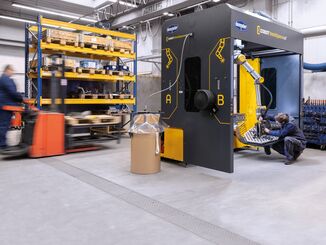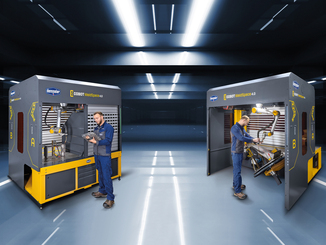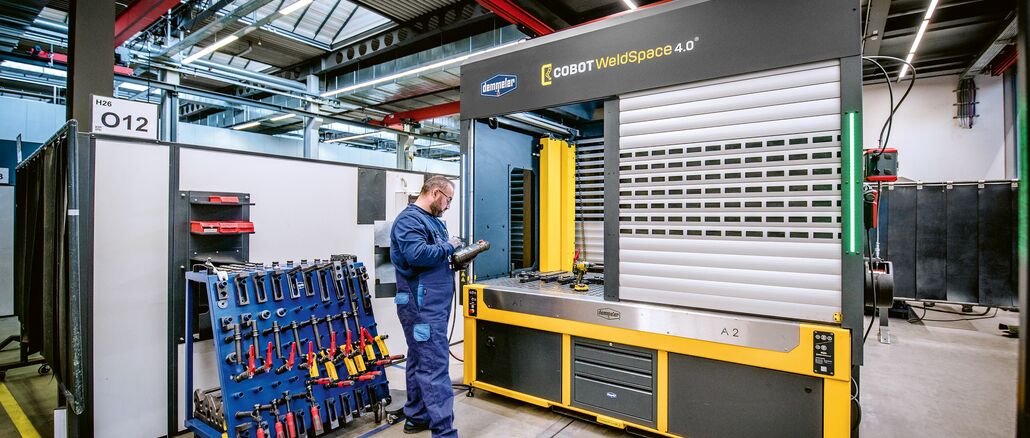
The family-owned company Knoll Maschinenbau GmbH relies on the Cobot WeldSpace 4.0 Table 24/12 from Demmeler to support its skilled workers in welding technology. The collaborative robot relieves valuable personnel of their tasks and delivers welding results of consistently high and reproducible quality. Multi-station operation with up to three workstations ensures high productivity. While the robot welds, the operator can set up and reclamp.
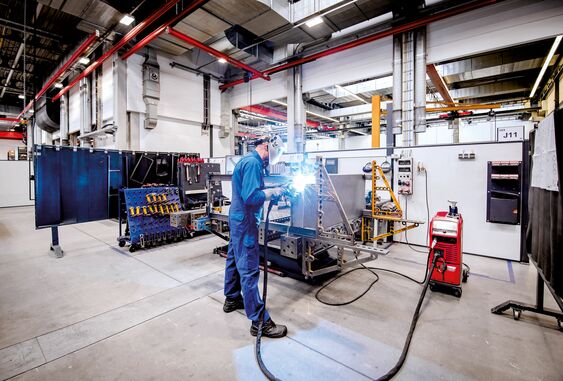
© Demmeler
Anyone who takes a look at the production facilities of Knoll Maschinenbau, a company based in Bad Saulgau with more than 1,200 employees worldwide, will be deeply impressed: Driverless transport systems automatically bring finished components into the large-scale storage system; all workstations are standardized and set up in a process-oriented manner; the walking distances between the stations have been optimized; display systems signal as soon as additional parts are needed at a workstation. “We started setting up our workplaces according to lean principles as early as 2006. Classically first according to the 5S principle: The welding workstations are all identical except for the product-specific tool. Each employee can change workstations and immediately find his or her way around. Over the years, other methods were added, such as ConWIP as a production control method and Andon boards as a visual control device,” explains Joachim Riebsamen, head of the body-in-white department at Knoll.
The “hidden champion” Knoll is a leading supplier of conveying systems, filter systems and pumps for metalworking. They transport and separate chips and cooling lubricants. The Automation business unit deals with solutions for demanding assembly and logistics tasks. “With our products, we help our customers save resources by extending the useful life of tools and cooling lubricants,” says Joachim Riebsamen. “With the area of automation, we have been entering a new business field for the last few years. We develop equipment for the automation of assembly and logistics processes.”
Shortage of skilled workers in the welding industry
Joachim Riebsamen and Holger Kleck, foremen of the welding shop at Knoll, also saw potential for automating certain manual welding workstations in their own production. The solution should be easy to program and profitable even for small batch sizes. The shortage of welding specialists also played a certain role. “Robotics makes the welding profession much more attractive.
Above all, young trainees can be more enthusiastic about welding work again,” says Holger Kleck. That’s where the collaborative welding robot from long-time partner Demmeler came in just right. The Cobot WeldSpace 4.0 Table 24/12 welding cell is a versatile automation solution: Whether welding in the aluminum thin sheet sector or welding in steel construction – it is simply set up at the desired location and can be put into operation after just a few hours. This enabled Holger Kleck to quickly integrate the Cobot system into the existing production processes.
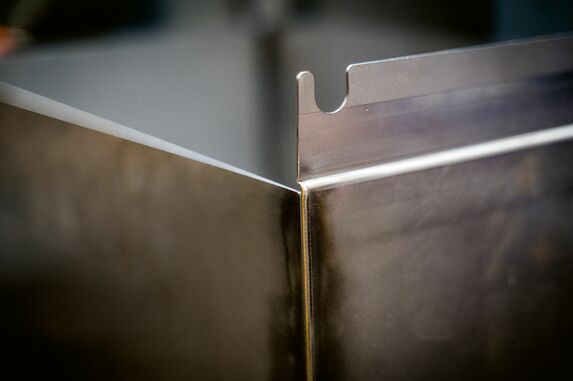
© Demmeler
Step by step to the perfect welding result
The result is high-quality welds of consistently high and reproducible quality. In addition to the precise torch movements, the intelligent welding equipment is responsible for this. Demmeler cooperates with Fronius and offers various Fronius welding systems with integration into the Demmeler WeldSpace 4.0 software. Knoll opted for the TPS400i CMT welder. The advantages of CMT welding, the so-called cold welding process, are the spatter-free welding result, the stable arc control, the high cost-effectiveness resulting from the very high welding speeds, and the low welding distortion. In combination with the user-friendly programming software, this provides a successful introduction to automated welding production. “Operating the Demmeler Cobot WeldSpace 4.0 Table 24/12 is really straightforward. Our welder had no programming knowledge beforehand, but was able to program his first welds without any problems after just one day of training,” says Holger Kleck.
This is because during so-called “teaching”, the torch on the robot arm is moved manually to the corresponding points where welding is to take place. Start and end points as well as intermediate waypoints are saved at the touch of a button on the handle. At the same time, programming is easy and intuitive with the help of the Demmeler-Cobot WeldSpace 4.0 software: The welder has full access to all relevant functions of the welding system with just one control panel and can select, set and save parameters in the robot controller. Without many clicks, professional welding sequences can be created in just a few minutes. For the selection of welding parameters, more than 100 welding jobs predefined and optimized by Demmeler are available from a protected job library, matched to material, power source, welding process and torch. Both linear and circular welds can thus also be programmed by the operator as reciprocating welds. The seam length and seam spacing can be defined individually. Before the actual welding, the welding process can now be simulated. The robot arm travels along the programmed weld seam and the operator can still correct the path if necessary.
“The result is absolutely uniform, almost like laser welding, only more flexible,” emphasizes Holger Kleck. “Previously, these parts, mainly containers, ledges and racks, were welded by hand, sometimes with auxiliary constructions. With the Cobot WeldSpace 4.0 Table 24/12, we are almost twice as fast.” Once programmed, it consistently welds one part after another to the highest quality.
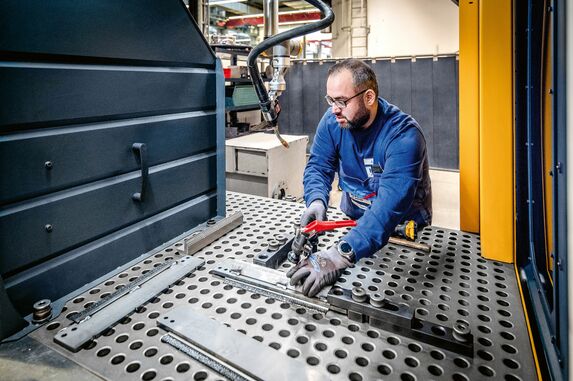
© Demmeler
Automated welding in shuttle mode
In addition to the intuitive programming and operating concept, the Demmeler Cobot WeldSpace 4.0 Table 24/12 convinces with its unique design. The plant is accessible from all sides and can also be loaded by crane. The enclosure automatically moves from workspace Space A to Space B and vice versa, depending on which workstation is being welded. This makes it possible to work in shuttle mode. Protected by retractable rolling doors with aluminum armor and viewing elements made of welder protection glass, the operator can set up the same workpieces on one side or reclamp to new welding tasks while the robot welds on the other side.
The further subdivision of the Space A workspace into A1 and A2 by means of a partition creates even one more workstation and enables work in three-station operation. Teach-in forces can also be used for inserting the components and starting the programmed welding processes. This frees up highly qualified welding specialists for more demanding activities. Particularly in the manual welding of classic sheet metal components, the new technology, welding with collaborative robots, can relieve valuable skilled workers from tiring routine and repetitive tasks. The physical strain on employees is also reduced: welding is a demanding job. Welders are often forced to work in constrained positions because the welds are often located in hard-to-reach areas. The integrated two-axis manipulator positions workpieces weighing up to 500 kg in the optimum tub position, eliminating the need for time-consuming reclamping of workpieces.
Profitable from batch size 1
The simple programming and the high flexibility of the system make it possible to weld workpieces automatically in a very short time. In this way, not only series but also small quantities are produced economically. “Our day-to-day business is batch size 1,” explains Joachim Riebsamen. Thanks to its high cost-effectiveness, fast commissioning and compact design, Cobot welding is made for small and medium-sized companies.
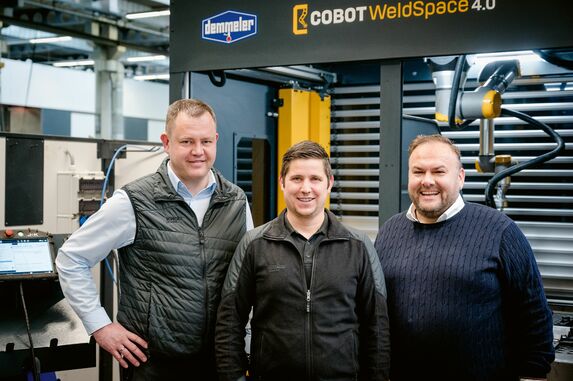
© Demmeler
Innovative partner for the future
The long-standing partnership between Knoll and Demmeler began back in 2001. “It all started with the equipment of some welding workstations with Demmeler 3D welding tables and the joint development of fixtures. Some of these are still in use with us today,” reports Joachim Riebsamen. When introducing the Lean concept, the modularity of the 3D welding table system was a major advantage.
“We need far fewer tools such as templates and measuring gauges to fix the components precisely. We simply orient ourselves to the hole pattern of the welding tables. This also means that we can largely dispense with fixtures on our robot systems,” emphasizes Holger Kleck. The Demmeler 3D welding table and clamping system can be easily integrated and expanded. Thanks to the multifunctional tool, significantly less equipment is required to clamp workpieces. This not only saves investment costs, but also storage capacity.
Further projects with the family-owned company from Unterallgäu are already being planned. “Next, we will test the Cobot WeldSpace 4.0 House 40/20 and RAIL 40/x variants with our larger components,” Joachim Riebsamen is pleased to report. The further developments of Cobot WeldSpace 4.0 enable highly productive welding with two robots simultaneously. The working area of the House 40/20 has a size of 4000 x 2000 x 2000 mm, the Rail 40/X can even be extended in length as required, because both the enclosure and the components can be moved as required on the Demmeler foundation rail system.
About Demmeler:
Innovations that became the standard for craft and industry have always characterized Demmeler’s successful company history. With “intelligent” products that significantly increase efficiency and significantly improve occupational safety. As an important milestone, Demmeler set the standard on the market as early as 1990 with the invention of the D28 3D clamping system and 3D welding table: extensively tested and optimized in its own production, the fixture system proved to be a quantum leap for metal processing worldwide and today counts as the international industry standard due to the enormous variety of application and combination options. With Cobot WeldSpace 4.0, companies from the skilled trades to industry can make their welding workplaces fit for the future. As a “hidden champion”, the company develops and manufactures highly automated products in the field of clamping and welding technology, rotary tables, robot-based tool changing systems and machine tool components at its Heimertingen site.
Web:
www.demmeler.com

